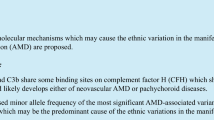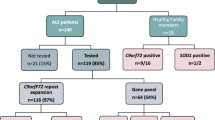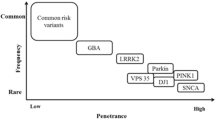Abstract
Purpose
Achromatopsia (ACHM) is an autosomal recessive cone disorder characterized by pendular nystagmus, photophobia, reduced visual acuity, and partial or total absence of color vision. Mutations in six genes (CNGA3, CNGB3, GNAT2, PDE6C, PDE6H, and ATF6) have been reported in ACHM. There is no information on these disease-associated genes in Thai population. This study aimed to investigate the molecular and clinical characteristics in Thai patients with ACHM.
Methods
Seven unrelated Thai patients with ACHM were recruited. Detailed ophthalmologic examination was performed. Polymerase chain reaction (PCR)-coupled single-strand conformation polymorphism (SSCP) screening followed by Sanger sequencing was used to identify sequence variants in all exons and splice junctions of three genes (CNGA3, CNGB3, and GNAT2). The pathogenicity of the detected variants was interpreted. Segregation analysis was performed to determine variant sharing in available family members.
Results
Four patients displayed different SSCP migration patterns. Sequence analysis revealed a reported pathogenic and a novel disease-associated variant in the CNGA3 gene. For the CNGB3 gene, we found two novel disease-associated variants and a reported variant of uncertain significance (VUS). Segregation analysis confirmed that the variants identified in each patient were present in the heterozygous state in their corresponding family members, which was consistent with an autosomal recessive mode of inheritance.
Conclusions
This study demonstrated the first molecular and clinical characterization of ACHM in Thai patients. The identification of disease-associated genes in a specific population leads to a personalized gene therapy benefiting those affected patients.



Similar content being viewed by others
References
Thiadens AA, Slingerland NW, Roosing S, van Schooneveld MJ, van Lith-Verhoeven JJ, van Moll-Ramirez N, van den Born LI, Hoyng CB, Cremers FP, Klaver CC (2009) Genetic etiology and clinical consequences of complete and incomplete achromatopsia. Ophthalmology 116(10):1984–1989. https://doi.org/10.1016/j.ophtha.2009.03.053
Michaelides M, Hunt DM, Moore AT (2004) The cone dysfunction syndromes. Br J Ophthalmol 88(2):291–297. https://doi.org/10.1136/bjo.2003.027102
Thomas MG, McLean RJ, Kohl S, Sheth V, Gottlob I (2012) Early signs of longitudinal progressive cone photoreceptor degeneration in achromatopsia. Br J Ophthalmol 96(9):1232–1236. https://doi.org/10.1136/bjophthalmol-2012-301737
Thiadens AA, Somervuo V, van den Born LI, Roosing S, van Schooneveld MJ, Kuijpers RW, van Moll-Ramirez N, Cremers FP, Hoyng CB, Klaver CC (2010) Progressive loss of cones in achromatopsia: an imaging study using spectral-domain optical coherence tomography. Invest Ophthalmol Vis Sci 51(11):5952–5957. https://doi.org/10.1167/iovs.10-5680
Kohl S, Marx T, Giddings I, Jägle H, Jacobson SG, Apfelstedt-Sylla E, Zrenner E, Sharpe LT, Wissinger B (1998) Total colourblindness is caused by mutations in the gene encoding the α-subunit of the cone photoreceptor cGMP-gated cation channel. Nat Genet 19(3):257–259. https://doi.org/10.1038/935
Kohl S, Baumann B, Broghammer M, Jagle H, Sieving P, Kellner U, Spegal R, Anastasi M, Zrenner E, Sharpe LT, Wissinger B (2000) Mutations in the CNGB3 gene encoding the beta-subunit of the cone photoreceptor cGMP-gated channel are responsible for achromatopsia (ACHM3) linked to chromosome 8q21. Hum Mol Genet 9(14):2107–2116. https://doi.org/10.1093/hmg/9.14.2107
Kohl S, Baumann B, Rosenberg T, Kellner U, Lorenz B, Vadala M, Jacobson SG, Wissinger B (2002) Mutations in the cone photoreceptor G-protein alpha-subunit gene GNAT2 in patients with achromatopsia. Am J Hum Genet 71(2):422–425. https://doi.org/10.1086/341835
Aligianis IA, Forshew T, Johnson S, Michaelides M, Johnson CA, Trembath RC, Hunt DM, Moore AT, Maher ER (2002) Mapping of a novel locus for achromatopsia (ACHM4) to 1p and identification of a germline mutation in the alpha subunit of cone transducin (GNAT2). J Med Genet 39(9):656–660. https://doi.org/10.1136/jmg.39.9.656
Chang B, Grau T, Dangel S, Hurd R, Jurklies B, Sener EC, Andreasson S, Dollfus H, Baumann B, Bolz S, Artemyev N, Kohl S, Heckenlively J, Wissinger B (2009) A homologous genetic basis of the murine cpfl1 mutant and human achromatopsia linked to mutations in the PDE6C gene. Proc Natl Acad Sci U S A 106(46):19581–19586. https://doi.org/10.1073/pnas.0907720106
Kohl S, Coppieters F, Meire F, Schaich S, Roosing S, Brennenstuhl C, Bolz S, van Genderen MM, Riemslag FC, European Retinal Disease C, Lukowski R, den Hollander AI, Cremers FP, De Baere E, Hoyng CB, Wissinger B (2012) A nonsense mutation in PDE6H causes autosomal-recessive incomplete achromatopsia. Am J Hum Genet 91(3):527–532. https://doi.org/10.1016/j.ajhg.2012.07.006
Ansar M, Santos-Cortez RL, Saqib MA, Zulfiqar F, Lee K, Ashraf NM, Ullah E, Wang X, Sajid S, Khan FS, Amin-ud-Din M, Smith JD, Shendure J, Bamshad MJ, Nickerson DA, Hameed A, Riazuddin S, Ahmed ZM, Ahmad W, Leal SM (2015) Mutation of ATF6 causes autosomal recessive achromatopsia. Hum Genet 134(9):941–950. https://doi.org/10.1007/s00439-015-1571-4
Chiang WC, Chan P, Wissinger B, Vincent A, Skorczyk-Werner A, Krawczynski MR, Kaufman RJ, Tsang SH, Heon E, Kohl S, Lin JH (2017) Achromatopsia mutations target sequential steps of ATF6 activation. Proc Natl Acad Sci U S A 114(2):400–405. https://doi.org/10.1073/pnas.1606387114
Remmer MH, Rastogi N, Ranka MP, Ceisler EJ (2015) Achromatopsia: a review. Curr Opin Ophthalmol 26(5):333–340. https://doi.org/10.1097/ICU.0000000000000189
Zelinger L, Cideciyan AV, Kohl S, Schwartz SB, Rosenmann A, Eli D, Sumaroka A, Roman AJ, Luo X, Brown C, Rosin B, Blumenfeld A, Wissinger B, Jacobson SG, Banin E, Sharon D (2015) Genetics and disease expression in the CNGA3 form of achromatopsia: steps on the path to gene therapy. Ophthalmology 122(5):997–1007. https://doi.org/10.1016/j.ophtha.2014.11.025
Li S, Huang L, Xiao X, Jia X, Guo X, Zhang Q (2014) Identification of CNGA3 mutations in 46 families: common cause of achromatopsia and cone-rod dystrophies in Chinese patients. JAMA Ophthalmol 132(9):1076–1083. https://doi.org/10.1001/jamaophthalmol.2014.1032
Goto-Omoto S, Hayashi T, Gekka T, Kubo A, Takeuchi T, Kitahara K (2006) Compound heterozygous CNGA3 mutations (R436W, L633P) in a Japanese patient with congenital achromatopsia. Vis Neurosci 23(3–4):395–402. https://doi.org/10.1017/s095252380623308x
Michalakis S, Schon C, Becirovic E, Biel M (2017) Gene therapy for achromatopsia. J Gene Med. https://doi.org/10.1002/jgm.2944
Kohl S, Jägle H, Wissinger B ZD (2004) Achromatopsia. In: Adam MP, Ardinger HH, Pagon RA (eds) GeneReviews®. University of Washington, Seattle, 1993–2020
Andersen MK, Christoffersen NL, Sander B, Edmund C, Larsen M, Grau T, Wissinger B, Kohl S, Rosenberg T (2010) Oligocone trichromacy: clinical and molecular genetic investigations. Invest Ophthalmol Vis Sci 51(1):89–95. https://doi.org/10.1167/iovs.09-3988
Wissinger B, Gamer D, Jagle H, Giorda R, Marx T, Mayer S, Tippmann S, Broghammer M, Jurklies B, Rosenberg T, Jacobson SG, Sener EC, Tatlipinar S, Hoyng CB, Castellan C, Bitoun P, Andreasson S, Rudolph G, Kellner U, Lorenz B, Wolff G, Verellen-Dumoulin C, Schwartz M, Cremers FP, Apfelstedt-Sylla E, Zrenner E, Salati R, Sharpe LT, Kohl S (2001) CNGA3 mutations in hereditary cone photoreceptor disorders. Am J Hum Genet 69(4):722–737. https://doi.org/10.1086/323613
Rosenberg T, Baumann B, Kohl S, Zrenner E, Jorgensen AL, Wissinger B (2004) Variant phenotypes of incomplete achromatopsia in two cousins with GNAT2 gene mutations. Invest Ophthalmol Vis Sci 45(12):4256–4262. https://doi.org/10.1167/iovs.04-0317
Audo I, Holder G, Moore A (2014) Inherited stationary disorders of the retina inherited chorioretinal dystrophies. Springer, Berlin. https://doi.org/10.1007/978-3-540-69466-3
DiCarlo JE, Mahajan VB, Tsang SH (2018) Gene therapy and genome surgery in the retina. J Clin Invest 128(6):2177–2188. https://doi.org/10.1172/JCI120429
Orita M, Iwahana H, Kanazawa H, Hayashi K, Sekiya T (1989) Detection of polymorphisms of human DNA by gel electrophoresis as single-strand conformation polymorphisms. Proc Natl Acad Sci U S A 86(8):2766–2770. https://doi.org/10.1073/pnas.86.8.2766
Richards S, Aziz N, Bale S, Bick D, Das S, Gastier-Foster J, Grody WW, Hegde M, Lyon E, Spector E, Voelkerding K, Rehm HL, Committee ALQA (2015) Standards and guidelines for the interpretation of sequence variants: a joint consensus recommendation of the American College of Medical Genetics and Genomics and the Association for Molecular Pathology. Genet Med 17(5):405–424. https://doi.org/10.1038/gim.2015.30
Venselaar H, Te Beek TA, Kuipers RK, Hekkelman ML, Vriend G (2010) Protein structure analysis of mutations causing inheritable diseases. An e-Science approach with life scientist friendly interfaces. BMC Bioinform 11:548. https://doi.org/10.1186/1471-2105-11-548
Michaelides M, Aligianis IA, Ainsworth JR, Good P, Mollon JD, Maher ER, Moore AT, Hunt DM (2004) Progressive cone dystrophy associated with mutation in CNGB3. Invest Ophthalmol Vis Sci 45(6):1975–1982. https://doi.org/10.1167/iovs.03-0898
Shuart NG, Haitin Y, Camp SS, Black KD, Zagotta WN (2011) Molecular mechanism for 3:1 subunit stoichiometry of rod cyclic nucleotide-gated ion channels. Nat Commun 2:457. https://doi.org/10.1038/ncomms1466
Li F-F, Huang X-F, Chen J, Yu X-D, Zheng M-Q, Lu F, Jin Z-B, Gan D-K (2015) Identification of novel mutations by targeted exome sequencing and the genotype-phenotype assessment of patients with achromatopsia. J Transl Med 13(1):334. https://doi.org/10.1186/s12967-015-0694-7
Zagotta WN, Siegelbaum SA (1996) Structure and function of cyclic nucleotide-gated channels. Ann Rev Neurosci 19(1):235–263. https://doi.org/10.1146/annurev.ne.19.030196.001315
Genead MA, Fishman GA, Rha J, Dubis AM, Bonci DM, Dubra A, Stone EM, Neitz M, Carroll J (2011) Photoreceptor structure and function in patients with congenital achromatopsia. Invest Ophthalmol Vis Sci 52(10):7298–7308. https://doi.org/10.1167/iovs.11-7762
Faillace MP, Bernabeu RO, Korenbrot JI (2004) Cellular processing of cone photoreceptor cyclic GMP-gated ion channels: a role for the S4 structural motif. J Biol Chem 279(21):22643–22653. https://doi.org/10.1074/jbc.M400035200
Ding XQ, Fitzgerald JB, Quiambao AB, Harry CS, Malykhina AP (2010) Molecular pathogenesis of achromatopsia associated with mutations in the cone cyclic nucleotide-gated channel CNGA3 subunit. Adv Exp Med Biol 664:245–253. https://doi.org/10.1007/978-1-4419-1399-9_28
Van Lith GHM (1973) General cone dysfunction without achromatopsia. In: Pearlman GHM (ed) Documenta ophthalmologica proceedings series, vol 2. Springer, Dordrecht. https://doi.org/10.1007/978-94-010-2697-0_17
Aboshiha J, Dubis AM, Carroll J, Hardcastle AJ, Michaelides M (2016) The cone dysfunction syndromes. Br J Ophthalmol 100(1):115–121. https://doi.org/10.1136/bjophthalmol-2014-306505
Vincent A, Wright T, Billingsley G, Westall C, Heon E (2011) Oligocone trichromacy is part of the spectrum of CNGA3-related cone system disorders. Ophthalmic Genet 32(2):107–113. https://doi.org/10.3109/13816810.2010.544366
Kohl S, Varsanyi B, Antunes GA, Baumann B, Hoyng CB, Jagle H, Rosenberg T, Kellner U, Lorenz B, Salati R, Jurklies B, Farkas A, Andreasson S, Weleber RG, Jacobson SG, Rudolph G, Castellan C, Dollfus H, Legius E, Anastasi M, Bitoun P, Lev D, Sieving PA, Munier FL, Zrenner E, Sharpe LT, Cremers FP, Wissinger B (2005) CNGB3 mutations account for 50% of all cases with autosomal recessive achromatopsia. Eur J Hum Genet 13(3):302–308. https://doi.org/10.1038/sj.ejhg.5201269
Zhang J, Sun X, Qian Y, Maquat LE (1998) Intron function in the nonsense-mediated decay of beta-globin mRNA: indications that pre-mRNA splicing in the nucleus can influence mRNA translation in the cytoplasm. RNA 4(7):801–815. https://doi.org/10.1017/s1355838298971849
Burkard M, Kohl S, Kratzig T, Tanimoto N, Brennenstuhl C, Bausch AE, Junger K, Reuter P, Sothilingam V, Beck SC, Huber G, Ding XQ, Mayer AK, Baumann B, Weisschuh N, Zobor D, Hahn GA, Kellner U, Venturelli S, Becirovic E, Charbel Issa P, Koenekoop RK, Rudolph G, Heckenlively J, Sieving P, Weleber RG, Hamel C, Zong X, Biel M, Lukowski R, Seeliger MW, Michalakis S, Wissinger B, Ruth P (2018) Accessory heterozygous mutations in cone photoreceptor CNGA3 exacerbate CNG channel-associated retinopathy. J Clin Invest 128(12):5663–5675. https://doi.org/10.1172/JCI96098
Bright SR, Brown TE, Varnum MD (2005) Disease-associated mutations in CNGB3 produce gain of function alterations in cone cyclic nucleotide-gated channels. Mol Vis 11:1141–1150
Nishiguchi KM, Sandberg MA, Gorji N, Berson EL, Dryja TP (2005) Cone cGMP-gated channel mutations and clinical findings in patients with achromatopsia, macular degeneration, and other hereditary cone diseases. Hum Mutat 25(3):248–258. https://doi.org/10.1002/humu.20142
Korkko J, Kaitila I, Lonnqvist L, Peltonen L, Ala-Kokko L (2002) Sensitivity of conformation sensitive gel electrophoresis in detecting mutations in Marfan syndrome and related conditions. J Med Genet 39(1):34–41. https://doi.org/10.1136/jmg.39.1.34
Hayashi K, Yandell DW (1993) How sensitive is PCR-SSCP? Hum Mutat 2(5):338–346. https://doi.org/10.1002/humu.1380020503
Mayer AK, Van Cauwenbergh C, Rother C, Baumann B, Reuter P, De Baere E, Wissinger B, Kohl S, Group AS (2017) CNGB3 mutation spectrum including copy number variations in 552 achromatopsia patients. Hum Mutat 38(11):1579–1591. https://doi.org/10.1002/humu.23311
Felden J, Baumann B, Ali M, Audo I, Ayuso C, Bocquet B, Casteels I, Garcia-Sandoval B, Jacobson SG, Jurklies B, Kellner U, Kessel L, Lorenz B, McKibbin M, Meunier I, de Ravel T, Rosenberg T, Ruther K, Vadala M, Wissinger B, Stingl K, Kohl S (2019) Mutation spectrum and clinical investigation of achromatopsia patients with mutations in the GNAT2 gene. Hum Mutat 40(8):1145–1155. https://doi.org/10.1002/humu.23768
Acknowledgements
The authors would like to thank the patients, their families and the normal volunteers who participated in the study.
Funding
This work was supported by the Siriraj Foundation (L-OA); the Chalermphrakiat Grant, Faculty of Medicine Siriraj Hospital, Mahidol University (L-OA, WT, CL).
Author information
Authors and Affiliations
Corresponding author
Ethics declarations
Conflict of interest
The authors declare that they have no conflict of interest.
Additional information
Publisher's Note
Springer Nature remains neutral with regard to jurisdictional claims in published maps and institutional affiliations.
Electronic supplementary material
Below is the link to the electronic supplementary material.
Fig. S1
Multiple protein sequence alignment of the CNGA3 and CNGB3 proteins across different species. Arrows indicate the variants sites located in highly conserved region of the CNGA3 and CNGB3 protein. “*”—single, fully conserved residue, “:”—conservation of strong groups, “.”—conservation of weak groups, and “_”—no consensus (TIFF 3795 kb)
Table S1
List of oligonucleotides used as PCR primers for SSCP analysis and product lengths. F: Forward primer. R: Reverse primer (DOCX 24 kb)
Table S2
In silico pathogenicity prediction of variants (DOCX 13 kb)
Rights and permissions
About this article
Cite this article
Jinda, W., Tuekprakhon, A., Thongnoppakhun, W. et al. Molecular and clinical characterization of Thai patients with achromatopsia: identification of three novel disease-associated variants in the CNGA3 and CNGB3 genes. Int Ophthalmol 41, 121–134 (2021). https://doi.org/10.1007/s10792-020-01559-2
Received:
Accepted:
Published:
Issue Date:
DOI: https://doi.org/10.1007/s10792-020-01559-2




